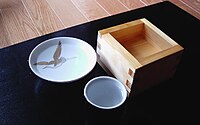
Photo from wikipedia
The present study was aimed at evaluating the effect of variable sodium carbonate (Na2CO3) loading during wet air oxidation (WAO) pretreatment of rice straw in reducing biomass recalcitrance. The research… Click to show full abstract
The present study was aimed at evaluating the effect of variable sodium carbonate (Na2CO3) loading during wet air oxidation (WAO) pretreatment of rice straw in reducing biomass recalcitrance. The research study was intended to increase the cellulose recovery, hemicellulose solubilization, lignin removal in the solid fraction and limiting the generation of inhibitors in the liquid fraction while reducing the chemical input. The operating condition of 169 °C, 4 bar, 18 min and 6.5 g/L Na2CO3 loading resulted in maximum cellulose recovery of 82.07% and hemicellulose solubilization and lignin removal of 85.43% and 65.42%, respectively, with a total phenolic content of 0.36 g/L in the liquid fraction. The crystallinity index increased from 47.69 to 51.25 along with enzymatic digestibility with an increase in Na2CO3 loading from 0 to 6.5 g/L as a result of removal of barriers for saccharification via effective cleavage of ether and ester bonds cross-linking the carbohydrates and lignin as indicated by FT-IR spectroscopy. A further increase in the Na2CO3 loading to 9.5 g/L did not significantly increase the sugar release. Thus, it was concluded that 6.5 g/L Na2CO3 during WAO is sufficient to increase the delignification and deacetylation, leading to significant changes in apparent cellulose crystallinity inter alia improvement in cellulose accessibility and digestibility of rice straw.
Journal Title: Korean Journal of Chemical Engineering
Year Published: 2018
Link to full text (if available)
Share on Social Media: Sign Up to like & get
recommendations!